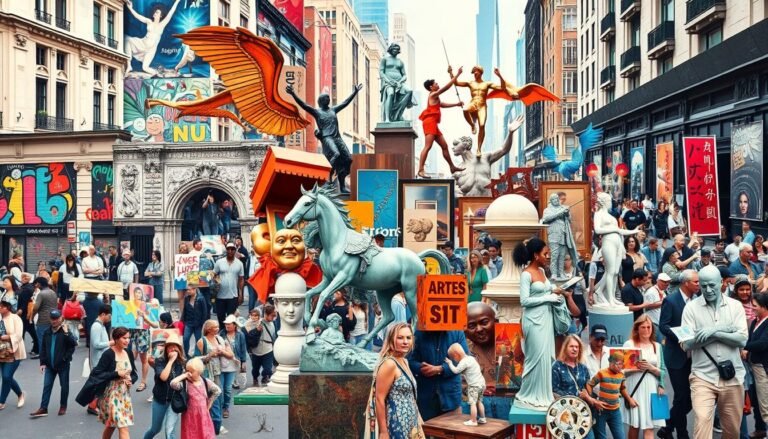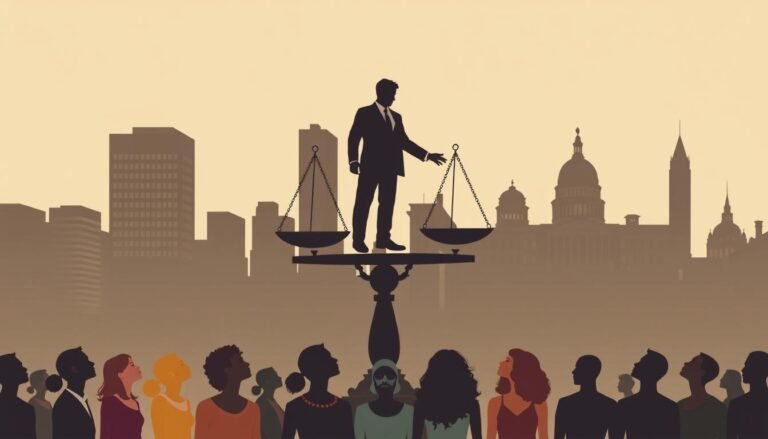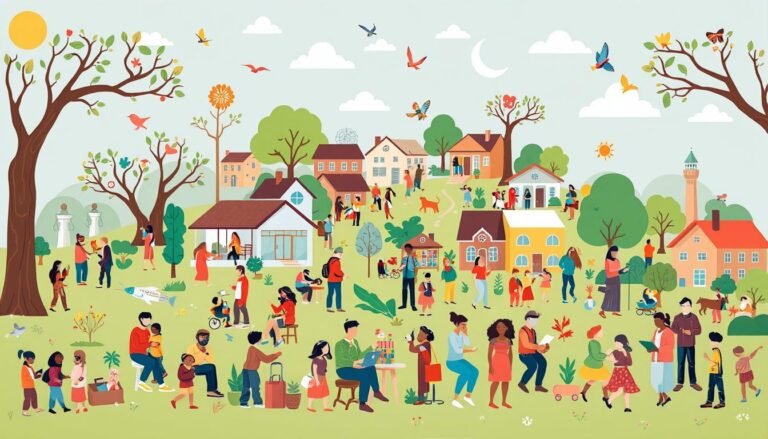The Sociology of Crime and Punishment
Ever thought about why some actions are crimes in one place but not another? This question is key to understanding the sociology of crime and punishment. It looks at how social norms, deviance, and the criminal justice system are linked.
In 2019, California’s Governor Gavin Newsom made big news by stopping capital punishment. This led to the end of San Quentin State Prison’s gas chamber. This shows how our views on crime and punishment change over time, based on what society values.
Sociologists study crime to find out why people commit crimes. They look at things like social control, strain theory, and labeling. They also examine how formal and informal social control shape our view of deviance and how we respond to it.
The criminal justice system is a big part of criminology. It includes law enforcement, courts, and corrections. This system shows what society values and often sparks debate. For example, the issue of mass incarceration in America is a big topic of discussion.
Key Takeaways:
- Sociology of crime explores why certain actions are criminalized in society
- Social control mechanisms shape our understanding of deviance
- The criminal justice system reflects societal values and norms
- Strain theory and labeling theory offer insights into criminal behavior
- Mass incarceration remains a significant issue in the American context
The Evolution of Sociological Perspectives on Crime
The study of crime has changed a lot over time. Early thinkers helped us understand why people commit crimes. They looked at it from different angles.
Durkheim’s Influence on Criminology
Emile Durkheim changed how we see social control. He believed crime is a natural part of society. It shows us what we can and can’t do.
He also studied suicide to show how being part of a group affects our actions. This idea helps us understand deviance better.
Weber’s Contribution to Legal Sociology
Max Weber added history to the study of crime. He talked about how societies change and how laws and authority work. His ideas help us see how rules and punishments change over time.
He showed us how institutions keep society in order. This is key to understanding crime and justice.
Marxist Approaches to Crime and Punishment
Karl Marx had a bold view of crime. He linked it to class struggles and unfairness in capitalist systems. Marxists believe the justice system controls the working class.
| Sociologist | Key Concept | Impact on Criminology |
|---|---|---|
| Durkheim | Social Integration | Crime as boundary-setting |
| Weber | Rationalization | Historical context of law |
| Marx | Class Conflict | Crime as result of inequality |
These views still guide us today in studying and dealing with crime. They help us understand deviance in our society.
Defining Crime in a Sociological Context
Crime is more than just breaking the law. Sociologists look at how social norms and values affect what we see as criminal behavior. This view helps us understand deviance and how society controls it.
The Classical School of criminology believed punishment should match the crime to prevent more crimes. This idea helped shape today’s justice system. Early thinkers like Gall and Lombroso thought certain physical traits could tell if someone was a “born criminal.” But we now know this is not true.
Today, criminologists study how society and culture affect crime. They ask three big questions:
- The nature of crime
- Why people commit crimes
- How society tries to control crime
Calling someone a criminal based on laws makes us think about who we call criminals. Critical criminologists suggest we should look at who benefits from calling certain actions illegal.
“The definition of crime shapes the questions criminologists explore, influencing our understanding of criminal behavior and its societal impact.”
Interesting facts show us patterns in crime. Most crimes are done by men, and they usually get caught between 21-25 years old. Poverty also plays a big role in crime, showing how social issues affect criminal behavior.
Social Control and Its Mechanisms
Social control shapes how we act and keeps society in order. It uses many methods, from subtle hints to strict laws. The criminal justice system is a big part of this, along with things like peer pressure that shape what we see as normal.
Formal vs. Informal Social Control
Formal social control is about official rules and punishments. The criminal justice system uses fines and jail to stop crime. Cities with more arrests and jail time for public offenses often see less crime.
Informal control comes from social rewards and punishments. Family, friends, and community affect our actions by giving us praise or criticism.
The Role of Institutions in Maintaining Order
Institutions play a big part in keeping society stable. Schools teach us to think and behave better. Summer jobs for young people in risky areas also help lower crime.
Business districts work together to keep their areas safe and clean. These efforts help stop bad behavior and keep everyone in line.
Socialization and Conformity
Socialization is crucial for fitting in. Programs like Functional Family Therapy help at-risk youth behave better. The media can also shape our values, but some say it can be biased.
Religion has long been seen as a key way to control society.
| Social Control Mechanism | Example | Impact |
|---|---|---|
| Formal Control | Criminal prosecutions | Emerged in 6th century B.C. Athens |
| Informal Control | Peer pressure | Shapes behavior through social approval |
| Institutional Control | School programs | Reduce aggressive behavior |
The Sociology of Crime and Punishment
The study of crime and punishment looks at how society deals with deviance. It combines criminology with social theories to grasp criminal behavior and its effects.
Social control is key in how society reacts to crime. It includes laws and social norms. Sociologists explore how these systems keep society in order and handle deviance.
Recent studies show how social factors and crime are linked. For instance, in 2019, California’s governor stopped capital punishment. This shows how attitudes towards punishment are changing.
Punishment theories are divided into two main types:
- Retributive theories focus on deserved punishment
- Utilitarian theories aim for crime prevention
Critics argue retributivism is hard to apply fairly. Utilitarianism struggles to balance individual rights with the greater good.
| Approach | Focus | Key Concepts |
|---|---|---|
| Retributive | Deserved punishment | Lex Talionis, culpability principle |
| Utilitarian | Crime reduction | Deterrence, rehabilitation, incapacitation |
These sociological views guide us in making fair and effective criminal justice policies. They push for a detailed way to tackle crime and deviance in society.
Theories of Criminal Behavior
Criminology looks into different theories to understand why people commit crimes. These theories help us see why people act criminally and how society tries to control them.
Strain Theory
Strain theory says crime happens because of society’s pressure. If people can’t reach their goals legally, they might turn to crime. This idea connects social unfairness to crime, showing why some groups commit more crimes.
Social Learning Theory
This theory looks at how we learn to act criminally through our social interactions. It says we learn bad behaviors by watching and copying others. Being around criminals makes it more likely we’ll think and act like them.
Labeling Theory
Labeling theory looks at how society’s reaction to crime can make people see themselves as criminals. When people are called criminals, they might start to see themselves that way too. This view shows how social shame can keep crime going.
“The way society treats those who break its rules often determines whether they will continue to do so.”
These theories give us important insights into why people commit crimes. They help us find ways to stop crime and make society fairer. By knowing why people act out, we can work towards a better, more just world.
The Criminal Justice System: A Sociological Analysis
The criminal justice system is key to keeping society in order. It’s made up of many parts that work together to enforce laws. These parts include law enforcement, courts, and corrections.
Sociologists study how social factors affect the system. They look at bias, discrimination, and inequality. This helps us see why some groups end up in prison more often or get tougher sentences.
- Increasing the chance of getting caught is better than long prison sentences for stopping crime.
- Programs like the Uniform Crime Reporting (UCR) and National Crime Victimization Survey (NCVS) have helped us understand crime better.
- The Violence Against Women Act of 1990 worked to improve how witnesses and victims were treated.
We need a broad approach to understanding crime. It’s not just about punishing people. We must also look at why they commit crimes and find ways to prevent it.
“The criminal justice system must balance punishment with rehabilitation to truly serve society.”
By looking at the criminal justice system sociologically, we can aim for fairness and effectiveness. This is key for making policies that tackle the social issues behind crime.
Incarceration and Its Social Consequences
The United States is facing a crisis with its high incarceration rates. This crisis deeply affects society. Minority communities are hit the hardest by the criminal justice system’s growth.
Mass Incarceration in America
Between 1980 and 2008, the U.S. incarceration rate jumped from 221 to 762 per 100,000 people. This is nearly eight times the historic average. Men are 90% of those in prison and in local jails.
The Prison Industrial Complex
The prison industrial complex shows how incarceration is linked to economic interests. It mainly affects those with less education. Most state prisoners only have a tenth-grade education, and about 70% didn’t finish high school.
Effects on Families and Communities
Incarceration has a big impact on families and communities, especially on African Americans. Young African American men with a high school diploma are likely to be in prison. The situation gets worse for those who didn’t graduate, with 37% in prison or jail by 2008.
| Demographic | Incarceration Rate | Education Level |
|---|---|---|
| Young African American Men (High School Diploma) | 1 in 10 | High School |
| Young African American Men (Dropouts) | 37% | Less than High School |
| African American Men (Born 1975-1979) | 1 in 4 lifetime risk | Varied |
The criminal justice system’s effects go beyond just incarceration. They also affect how often people return to crime and their chance to move up in life. For many African American men, going to prison is more common than joining the military or going to college.
Restorative Justice: An Alternative Approach
Restorative justice offers a new way to deal with crime and punishment. It aims to fix the harm done by criminals by bringing together offenders, victims, and community members. This method is different from traditional punishments, focusing on healing and helping people change.
In the U.S., many states use family group conferences (FGCs) in their restorative justice programs. These meetings are based on the idea of reintegrative shaming. They use social control to prevent crime. The results show lower crime rates.
Studies show that restorative justice works well. In Bethlehem, PA, police-led meetings made victims happy and cut down on crime. In Indianapolis, a program had a 20% rearrest rate for young people, compared to 34% for others after six months.
“Restorative justice has been shown to lead to higher levels of victim satisfaction compared to traditional court proceedings.”
Victim-impact panels are another part of restorative justice. They are used for different crimes like theft, assault, and domestic violence. Even though the results are mixed, they are still important in restorative justice.
| Restorative Justice Approach | Traditional Criminal Justice System |
|---|---|
| Focus on repairing harm | Focus on punishment |
| Involves victims, offenders, and community | Primarily involves state and offender |
| Aims for rehabilitation and reduced recidivism | Aims for deterrence and retribution |
| Promotes dialogue and understanding | Often adversarial in nature |
Restorative justice can save money by reducing the number of cases in court. It’s also used in schools to solve conflicts and stop bad behavior. As the criminal justice system changes, restorative justice is becoming a key alternative to old ways of punishing people.
Crime Prevention Strategies: A Sociological Perspective
Crime prevention strategies are key to keeping communities safe and reducing crime. Experts in criminology have found many ways to fight crime and make communities safer.
Community-Based Initiatives
Community-based programs aim to strengthen social bonds and community spirit. These efforts have greatly lowered crime rates. For example, New York City saw a 39% drop in major crimes and a 49% fall in murders since 1993, thanks to community policing.
Environmental Design and Crime Prevention
How our surroundings affect crime is big. Improving lighting, using surveillance cameras, and making safe spaces can really help. Studies show CCTV cuts crime by 16% overall and by 51% in parking areas.
Early Intervention Programs
Programs that help young people at risk can stop them from turning to crime. The Perry Pre-school project, for instance, helped disadvantaged black kids a lot. It saved $117 on welfare, prison, and other costs for every dollar spent.
| Prevention Strategy | Effectiveness | Cost-Benefit Ratio |
|---|---|---|
| Community-Based Initiatives | 39% reduction in major crime | High |
| Environmental Design | 16% overall crime reduction | Medium |
| Early Intervention Programs | $117 saved for every $1 spent | Very High |
These methods show how important it is to tackle the causes of crime and make places less inviting for crime. By using these strategies, communities can aim for a safer and more secure future.
Conclusion
The Sociology of Crime and Punishment takes us deep into how society, deviance, and justice interact. From Dostoevsky’s classic novel to today’s criminology, we see how social factors influence criminal behavior and how society reacts. This journey shows us why it’s key to look at crime in its social setting.
Social control, both official and unofficial, is vital for keeping society stable. The criminal justice system tries to maintain law and order but struggles to balance punishment with helping offenders change. The issue of mass incarceration shows the need for new ways, like restorative justice.
As we move forward, criminology keeps changing. Now, crime prevention includes community efforts and designing safer environments. As society evolves, so must our views on crime and punishment. By using sociology, we can find better and fairer ways to deal with crime. This helps us tackle the deep causes of crime and build safer communities.
Source Links
- Sociology of punishment
- Crime & Punishment sociology
- Sociological Theories of Crime and Deviance | National University
- 7.2 Theoretical Perspectives on Deviance and Crime – Introduction to Sociology 3e | OpenStax
- Sociological Perspectives on Punishment – ReviseSociology
- Sociology of Crime (Criminology)
- Crime and Society: Sociology, Types & Causes
- Vital City | Social Control Works: Lessons for Criminal Justice Reformers
- Social control
- Criminology – Sociology, Theories, Causes
- Criminology: Theories of Crime & Punishment
- What Is Criminology? The Study of Crime and Criminal Minds
- Sociology of Crime Research Paper Topics
- Criminology & Criminal Justice BA
- Incarceration & social inequality
- The Sociology of Punishment and the Effects of Imprisonment on Families
- Restorative Justice Literature Review
- Longdom Publishing SL | Open Access Journals
- A Method for the Madness: Restorative Justice as a Valid Mode of Punishment and an Advancement of Catholic Social Thought
- Crime Control, Prevention and Punishment – Unit 4
- Crime Prevention and Control Strategies – ReviseSociology
- Crime Prevention: Meaning, Types & Strategies
- An Analysis of Crime and Punishment
- Crime and Punishment







